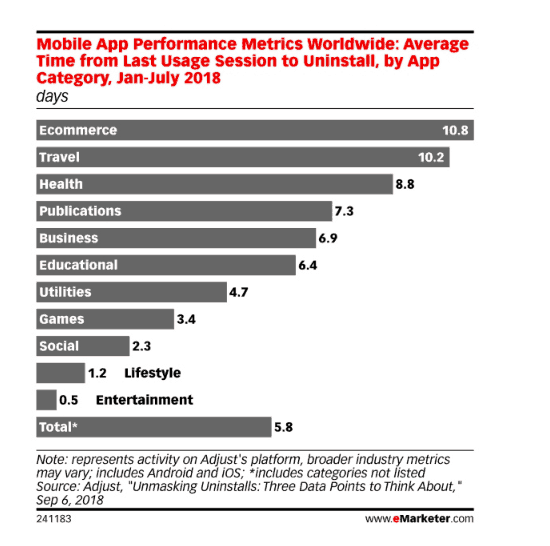Not long ago we shared with you the biggest mistakes in ecommerce app design—we talked to several experts about the most common design flaws in ecommerce mobile apps, and what companies can do to improve the experience for the user. The main theme that emerged was that app designers should focus on personalization and superior navigation.
Now, we know that designing an ecommerce app is a challenge; however, the greater challenge—and the one that’s slowing growth for online businesses—is designing a marketing strategy that actually speaks to customers.
After all, a good app is nothing without a good marketing plan.
So once again, we turned to the experts for some actionable tips, this time for marketing ecommerce apps. Let’s see what these ecommerce experts had to say.
Tip #1: Optimize Your App Listing
As the number of ecommerce apps climbs on both Android and iOS platforms, it becomes increasingly difficult for users to discover your app and for you to stand out from the competition. That’s why app store optimization (ASO) is more crucial than ever.
Don’t just take our word for it—Elise Dopson, freelance content writer for SaaS and marketing companies, explains why in more detail:
“[A big mistake is] failing to optimize your app listing on platforms like the App Store or Google Play App Store. Treat these platforms like a search engine, and use SEO techniques for your app listing to make it visible to users searching for something your app offers.
“For example: If you’re creating an app that allows people to take notes, optimize the app listing for “note taking app” or “app to take notes.” That way, you’re able to target people within an interest (even if that’s not related to your brand) and make your app visible to them.
“If people can’t find your app, you aren’t going to get anything from it—or meet the goals you set!”
Tip #2: Share Relevant Content With Users
Mobile apps touch all aspects of our lives today—we use apps to order food, carpool, get our shopping done … and basically everything else. But despite our dependence on apps, we routinely uninstall them from our phones.
The same is true for retail apps as well. According to stats by Synchrony– a financial service company, users deleted retail apps primarily for two reasons—free up storage space( 34%) or shopping less with a retailer (34%), however, most users tend to wait longer to uninstall ecommerce apps than other types.

This is clearly an opportunity for ecommerce marketers to do more with their app marketing plan!
What tactics can ecommerce marketers use to boost engagement and keep users tuned in? The answer: share content your users will care about—and that starts with creating a clear value proposition.
Content marketing strategist Alaura Weaver shares her two cents:
“Your app is an opportunity to reach people literally where they’re at with relevant content. Why not let your user tell you their top priorities during onboarding and send notifications with lifestyle-enhancing content? Use that information alongside geotargeting to give them super-relevant information that they can act on.
“If you’re a clothing seller, send a morning notification with seasonal styling tips for work with a link to a blog post or video. If you specialize in kids’ toys and you’re targeting customers in a rainy/snowy area, send out some weather-specific ideas to help parents keep their kids away from screens.”
Tip #3: Prevent Push Notification Abuse
One of Alaura’s suggestions was to send notifications to your users, and that’s a valuable tip. But be careful—one of the cardinal sins of mobile app marketing is going overboard with push notifications. In fact, according to one study, 71% of users uninstall apps due to annoying push notifications.
Cara Hogan, content strategist at Zaius, explains how ecommerce app marketers can get the most out of their push notifications instead of pushing users away:
“While push notifications have significantly higher open rates than email or other marketing channels, they can also be incredibly intrusive.
“If you use them indiscriminately, you can quickly annoy or upset your buyers. Be careful to get your buyers to opt in for notifications and then make sure you personalize the notifications to their interests. That could be anything from an alert for a sale on a specific product to an alert when an item is back in stock. You want to aim for a push notification to signal excitement, not annoyance.”
Tip #4: Invest In Email Marketing
Push notifications have higher opt-in rates and higher CTR than emails, and they’re integral to cross-platform delivery. Comparatively speaking, you might think email is irrelevant to mobile app marketing. It’s not—but users do expect different things from push and email.
Email conversion strategist Val Geisler says email is overlooked, even though it’s easy to use in your marketing plan:
“Email is a missing strategy for most mobile apps and it’s really the easy button you can push quite quickly. Create an onboarding campaign. Collect email addresses on signup and then send messaging based on their action—or inaction—with your app.”
If you already have an email newsletter tied to your ecommerce website, don’t keep that separate from your mobile app, Val adds—use the platform and audience you’ve already established to promote the app too!
“On the flip side, if you already have an email for your website and you’re adding an app to your offerings, forgetting to add an email dedicated to the app into your onboarding and ongoing retention is a huge miss. Don’t just send a one-off email to notify your existing subscribers. Add it into your onboarding campaign too so *everybody* knows about your app moving forward.
“Apps are often about awareness and regular use so you have to go to where your customers are first. Where are they? In their inbox.”
Tip #5: Add Features & Campaigns That Boost Virality
Apps like Pokémon Go and Candy Crush are household names for a reason: They grabbed users’ attention right from the start which led to their massive downloads across markets.

The secret to their success? They were built for virality. Vanhishikha Bhargava, content marketer at GetSocial, explains what this means and how ecommerce apps can follow suit:
“The mobile apps built are not designed for virality—they lack the social layer and hence suffer from churns or lower engagement rates. Engagement leads to retention and retention is what leads to growth today. A sense of loyalty towards a brand, its store, and its app, is what leads to not losing the customer interest and higher average order values. So implement a social layer in the design of the app itself.”
While a lot of what she says depends on the ease of use which in turn is dependent on app design, the quickest way of attracting users (and downloads) that marketers can use is by adding features and launching campaigns that boost awareness and downloads.
One of the most successful examples is that of Airbnb and HotelTonight which used in-app referral campaigns and mobile deep linking to attract users and app download.
Tip #6: Steer Away From Vanity Metrics
It’s just foolish to run an app marketing campaign without data to back it up. Most marketers have adopted a data-driven approach—and that’s a good thing—but too often they build campaigns on metrics that ultimately don’t matter.
The end result should be obvious. Jonathan Dane, CEO, and founder of klientboost, explains why you shouldn’t focus on surface-level metrics:
“CPIs are great—but when you look at engagement intent differences between custom, lookalike, and saved audiences with Facebook ads, for example, you’ll quickly notice how many installs never lead to opens nor registrations. So there’s a big intent disparity with keywords, audiences, and placements that people aren’t looking at when it comes to proving ROI.”
If you want your app marketing to be effective, you need to base your strategies on data—and not just vanity metrics that reflect surface-level growth. Instead, find a north-star metric to guide your campaigns toward long-term success.
Wrapping It Up
We believe 2019 is a year of promise, and we hope these tips will help you transform your app marketing strategy this year.
You may be thinking that your ecommerce app needs more than just a better marketing plan. If you would like help redesigning your app, or developing a new one, reach out to one of our product strategists today!



